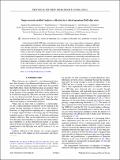Files in this item
Supercurrent-enabled Andreev reflection in a chiral quantum Hall edge state
Item metadata
| dc.contributor.author | Michelsen, Andreas B. | |
| dc.contributor.author | Recher, Patrik | |
| dc.contributor.author | Braunecker, Bernd | |
| dc.contributor.author | Schmidt, Thomas L. | |
| dc.date.accessioned | 2023-02-01T17:30:10Z | |
| dc.date.available | 2023-02-01T17:30:10Z | |
| dc.date.issued | 2023-01-31 | |
| dc.identifier | 282921334 | |
| dc.identifier | 6ec696e0-1a63-4017-b21b-09417893ab2a | |
| dc.identifier | 85148328820 | |
| dc.identifier.citation | Michelsen , A B , Recher , P , Braunecker , B & Schmidt , T L 2023 , ' Supercurrent-enabled Andreev reflection in a chiral quantum Hall edge state ' , Physical Review Research , vol. 5 , no. 1 , 013066 . https://doi.org/10.1103/PhysRevResearch.5.013066 | en |
| dc.identifier.issn | 2643-1564 | |
| dc.identifier.other | ArXiv: http://arxiv.org/abs/2203.13384v2 | |
| dc.identifier.other | ORCID: /0000-0002-7077-8825/work/128097432 | |
| dc.identifier.uri | https://hdl.handle.net/10023/26878 | |
| dc.description | Funding: ABM and TLS acknowledge support from the National Research Fund, Luxembourg under the grant ATTRACT, Grant No. A14/MS/7556175/MoMeSys. ABM and BB acknowledge support from St. Leonard’s European Inter-University Doctoral Scholarship of the University of St. Andrews. PR acknowledges financial support by the Deutsche Forschungsgemeinschaft (DFG, German Research Foundation) within the framework of Germany’s Excellence Strategy-EXC-2123 QuantumFrontiers-390837967. | en |
| dc.description.abstract | A chiral quantum Hall (QH) edge state placed in proximity to an s-wave superconductor experiences induced superconducting correlations. Recent experiments have observed the effect of proximity coupling in QH edge states through signatures of the mediating process of Andreev reflection. We present the microscopic theory behind this effect by modeling the system with a many-body Hamiltonian, consisting of an s-wave superconductor, subject to spin-orbit coupling and a magnetic field, which is coupled by electron tunneling to an integer QH edge state. By integrating out the superconductor we obtain an effective pairing Hamiltonian in the QH edge state. We clarify the qualitative appearance of nonlocal superconducting correlations in a chiral edge state and analytically predict the suppression of electron-hole conversion at low energies (Pauli blocking) and negative resistance as experimental signatures of Andreev reflection in this setup. In particular, we show how two surface phenomena of the superconductor, namely, Rashba spin-orbit coupling and a supercurrent due to the Meissner effect, are essential for the Andreev reflection. Our work provides a promising pathway to the realization of Majorana zero modes and their parafermionic generalizations. | |
| dc.format.extent | 14 | |
| dc.format.extent | 829931 | |
| dc.language.iso | eng | |
| dc.relation.ispartof | Physical Review Research | en |
| dc.subject | QC Physics | en |
| dc.subject | TK Electrical engineering. Electronics Nuclear engineering | en |
| dc.subject | T-NDAS | en |
| dc.subject | MCC | en |
| dc.subject | NCAD | en |
| dc.subject.lcc | QC | en |
| dc.subject.lcc | TK | en |
| dc.title | Supercurrent-enabled Andreev reflection in a chiral quantum Hall edge state | en |
| dc.type | Journal article | en |
| dc.contributor.institution | University of St Andrews. School of Physics and Astronomy | en |
| dc.contributor.institution | University of St Andrews. Centre for Designer Quantum Materials | en |
| dc.contributor.institution | University of St Andrews. Condensed Matter Physics | en |
| dc.identifier.doi | https://doi.org/10.1103/PhysRevResearch.5.013066 | |
| dc.description.status | Peer reviewed | en |
This item appears in the following Collection(s)
Items in the St Andrews Research Repository are protected by copyright, with all rights reserved, unless otherwise indicated.

